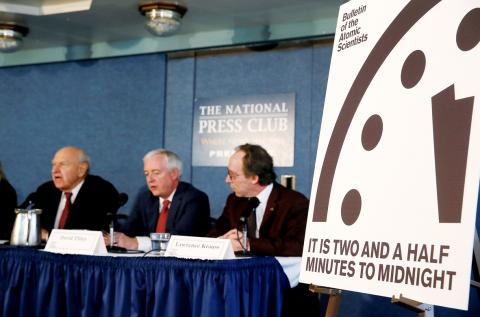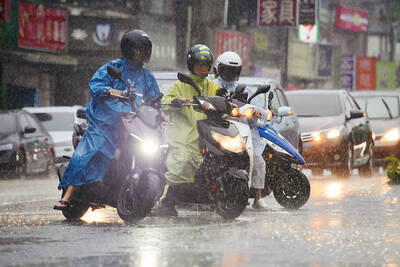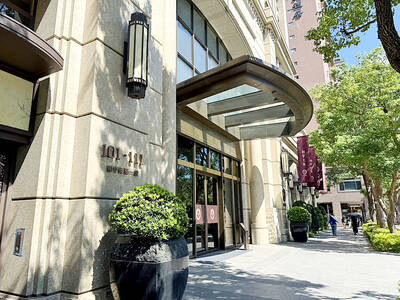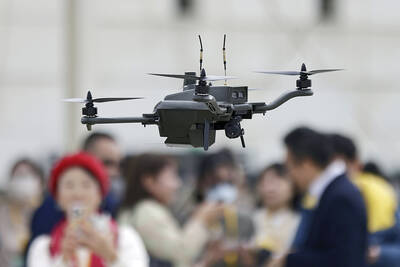It is getting closer to midnight.
On Thursday, the group of scientists who orchestrate the Doomsday Clock, a symbolic instrument informing the public when the Earth is facing imminent disaster, moved its minute hand from three to two-and-a-half minutes before the final hour.
It was the closest the clock had been to midnight since 1953, the year after the US and the Soviet Union conducted competing tests of the hydrogen bomb.

Photo: Reuters
Though scientists decide on the clock’s position, it is not a scientific instrument, or even a physical one. The movement of its symbolic hands is decided upon by the Science and Security Board of the Bulletin of the Atomic Scientists.
The organization introduced the clock on the cover of its June 1947 edition, placing it at seven minutes to midnight. Since then, it has moved closer to midnight and farther away, depending on the board’s conclusions.
Thursday’s announcement was made by Rachel Bronson, the executive director and publisher of the bulletin.
She was assisted by theoretical physicist Lawrence Krauss, climate scientist and meteorologist David Titley, and former US ambassador Thomas Pickering.
Bronson, in a post-announcement interview, explained why the board had included the 30-second mark in the measurement.
She said it was an attention-catching signal that was meant to acknowledge “what a dangerous moment we’re in, and how important it is for people to take note.”
“We’re so concerned about the rhetoric and the lack of respect for expertise that we moved it 30 seconds,” she said.
“Rather than create panic, we’re hoping that this drives action,” she said.
In an opinion piece for the New York Times, Titley and Krauss elaborated on their concerns, citing the increasing threats of nuclear weapons and climate change, as well as US President Donald Trump’s pledges to impede what they see as progress on both fronts, as reasons for moving the clock closer to midnight.
“Never before has the bulletin decided to advance the clock largely because of the statements of a single person,” they wrote. “But when that person is the new president of the United States, his words matter.”
In 1990, at the end of the Cold War, the clock was at 10 minutes to midnight. The next year, it was a full 17 minutes away, at 11:43.
However, over the next two decades the clock slowly ticked back. By 2015, the scientists were back in a state of unmitigated concern, with the clock at three minutes to midnight, the closest it had been since 1984.
“Unchecked climate change, global nuclear weapons modernizations, and outsized nuclear weapons arsenals pose extraordinary and undeniable threats to the continued existence of humanity,” the bulletin said.
“World leaders have failed to act with the speed or on the scale required to protect citizens from potential catastrophe,” it said.
“These failures of political leadership endanger every person on Earth,” it added.

The combined effect of the monsoon, the outer rim of Typhoon Fengshen and a low-pressure system is expected to bring significant rainfall this week to various parts of the nation, the Central Weather Administration (CWA) said. The heaviest rain is expected to occur today and tomorrow, with torrential rain expected in Keelung’s north coast, Yilan and the mountainous regions of Taipei and New Taipei City, the CWA said. Rivers could rise rapidly, and residents should stay away from riverbanks and avoid going to the mountains or engaging in water activities, it said. Scattered showers are expected today in central and

COOPERATION: Taiwan is aligning closely with US strategic objectives on various matters, including China’s rare earths restrictions, the Ministry of Foreign Affairs said Taiwan could deal with China’s tightened export controls on rare earth metals by turning to “urban mining,” a researcher said yesterday. Rare earth metals, which are used in semiconductors and other electronic components, could be recovered from industrial or electronic waste to reduce reliance on imports, National Cheng Kung University Department of Resources Engineering professor Lee Cheng-han (李政翰) said. Despite their name, rare earth elements are not actually rare — their abundance in the Earth’s crust is relatively high, but they are dispersed, making extraction and refining energy-intensive and environmentally damaging, he said, adding that many countries have opted to

FORCED LABOR: A US court listed three Taiwanese and nine firms based in Taiwan in its indictment, with eight of the companies registered at the same address Nine companies registered in Taiwan, as well as three Taiwanese, on Tuesday were named by the US Department of the Treasury’s Office of Foreign Assets Control (OFAC) as Specially Designated Nationals (SDNs) as a result of a US federal court indictment. The indictment unsealed at the federal court in Brooklyn, New York, said that Chen Zhi (陳志), a dual Cambodian-British national, is being indicted for fraud conspiracy, money laundering and overseeing Prince Holding Group’s forced-labor scam camps in Cambodia. At its peak, the company allegedly made US$30 million per day, court documents showed. The US government has seized Chen’s noncustodial wallet, which contains

SUPPLY CHAIN: Taiwan’s advantages in the drone industry include rapid production capacity that is independent of Chinese-made parts, the economic ministry said The Executive Yuan yesterday approved plans to invest NT$44.2 billion (US$1.44 billion) into domestic production of uncrewed aerial vehicles over the next six years, bringing Taiwan’s output value to more than NT$40 billion by 2030 and making the nation Asia’s democratic hub for the drone supply chain. The proposed budget has NT$33.8 billion in new allocations and NT$10.43 billion in existing funds, the Ministry of Economic Affairs said. Under the new development program, the public sector would purchase nearly 100,000 drones, of which 50,898 would be for civil and government use, while 48,750 would be for national defense, it said. The Ministry of